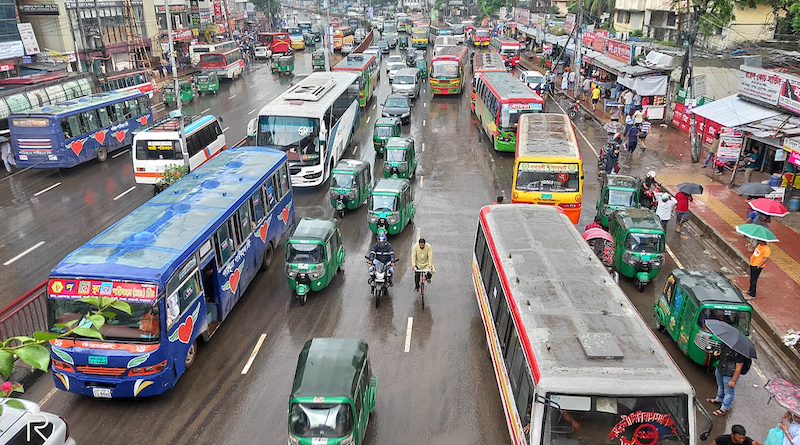Reimagining Bangladesh’s Economic Progress – Analysis
By Soumya Bhowmick*
Bangladesh’s economy has grown at impressive rates in the last decade. Even as one of the few countries to maintain a high growth rate during the COVID-19 pandemic — recording 6.94 per cent growth in 2021 — Bangladesh has started to show signs of stalling. Recent mass protests against Prime Minister Sheikh Hasina’s government are a direct consequence of fears about a collapsing economy.
Global macroeconomic shocks since 2020 have been brutal — pandemic-induced supply chain disruptions, extreme climatic events, geopolitical tensions and the Ukraine–Russia war. It has not been easy, especially for countries of the Global South like Bangladesh with fewer financial resources and less economic resilience.
Earlier this year, the International Monetary Fund (IMF) approved a US$4.7 billion loan sought by Bangladesh’s government as a ‘stabilisation’ package, unlike the ‘bailout’ packages sought by Sri Lanka and Pakistan. While Bangladesh is not in a fully-fledged economic emergency, the country must draw lessons from various areas to combat this latent crisis and mitigate structural flaws in the domestic economy.
The Ready Made Garments (RMG) concentrated manufacturing sector driving Bangladesh’s economic progress poses homogeneity risks for its export basket. Not only has volatile global demand impacted this sector, but the production side is heavily dependent on unskilled labour working in poor conditions. While the service sector normally complements the RMG industry, it also provides a solid long-term alternative to the RMG-dominated export mix.
Bangladesh’s tax administration is also riddled with corruption and lacks sufficient revenue mobilisation. The poor state of transport and energy access, with a rise in input costs in recent times, has stalled many infrastructure projects and widened budget deficits. More robust anti-corruption reforms coupled with structured revenue enhancement and expenditure rationalisation measures are crucial.
Decreasing exports of RMGs, rising import bills for necessary commodities such as food and energy and the direct impact of fiscal deficits have deteriorated the current account balance. A fall in foreign direct investment, mainly due to an unfavourable business climate, has also impacted the capital account. This has brought balance of payment issues to the fore. This should be ameliorated through export promotion strategies and lowering Bangladeshi exports’ dependence on imported inputs.
Corresponding macroeconomic parameters impacted by the recent global events, including a contraction in remittances, foreign exchange depletion and a weakening currency pose serious economic concerns. Bangladesh needs to take urgent action to stabilise its economy. This needs to be complemented with adequate social security measures to protect vulnerable sections of society.
The demand–supply gap in Bangladesh’s energy sector also needs to be addressed. Technological upgrades and a faster transition towards renewables can subsume excess energy demand without compromising domestic economic activities.
Recent inflationary pressures, mainly due to rising food and fuel prices and exacerbated by the Russia–Ukraine conflict, pose short- to medium-term trade threats. This also provides impetus to create better domestic capacities and diversify global partnerships for economic resilience.
Bangladesh is particularly vulnerable to the effects of climate change. The 2021 Global Climate Risk Index rated Bangladesh as the seventh worst-affected country by extreme weather events. Bangladesh’s low-lying topography means rising sea levels could displace an estimated 15–30 million Bangladeshis from coastal regions. Internal migration into urban areas without proper planning and poor governance could intensify the situation by increasing the proliferation of slums with hazardous living conditions.
While Sri Lanka and Pakistan were also burdened by external debt servicing commitments, this is not the case for Bangladesh. Bangladesh’s external debt-to-GDP ratio stood at 11.87 per cent, much lower than the IMF-mandated threshold of 40 per cent. Significant volumes of savings and investments need to be stimulated to catalyse robust economic growth in the years to come.
But Bangladesh’s banking sector is undergoing intense instability. The country’s largest private bank, Islami Bank, had to seek financial support from the central bank to restore depositor confidence. This was mainly due to loan frauds that Islami Bank faced from influential business groups and individuals. Many other banks in Bangladesh faced the same issue. The ongoing banking crisis and capital flight from Bangladesh, as well as cronyism and bureaucratic corruption, are deeply rooted in the country’s patronage politics. This has worsened in the last decade.
Despite Bangladesh’s progress on various socioeconomic indicators, the country needs to address inequality to ensure an inclusive development framework. Right now, early signs of a growth slump are coming to the surface. A deep understanding and reform of the structural vulnerabilities in Bangladesh’s economy could ensure economic growth and sustainable development in the longer term.
*About the author: Soumya Bhowmick is Associate Fellow at the Observer Research Foundation.
Source: This article was published by East Asia Forum

